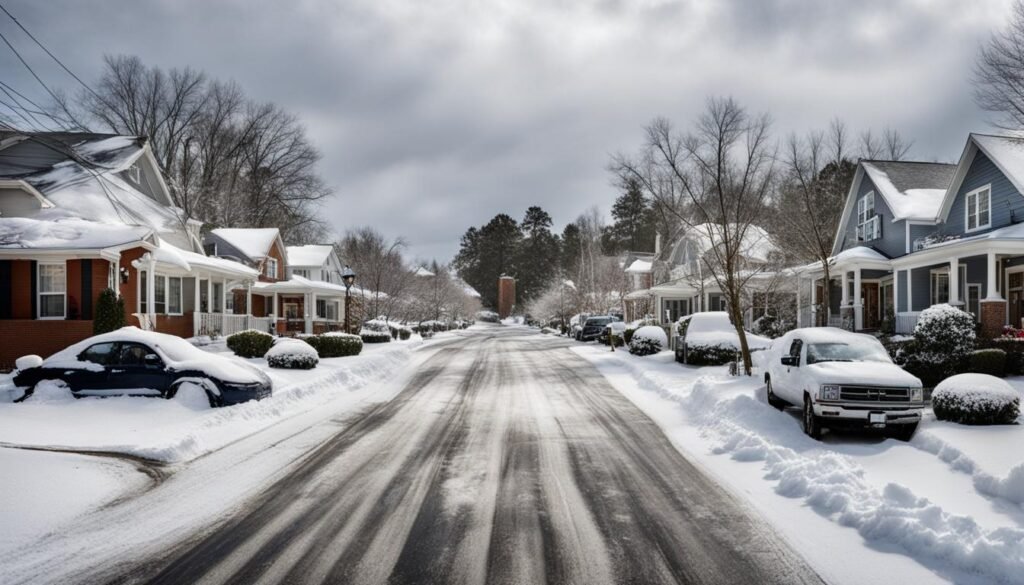Are you wondering if Charlotte, North Carolina, experiences snowfall during the winter season? Well, you’ve come to the right place! As a resident of Charlotte, I can provide you with some insights into the snowfall patterns in our beautiful city.
Historical climate data suggests that the chances of snow in Charlotte before the end of the year are relatively low. In fact, only about 14% of previous snow days have occurred in November or December. The majority of snowfall in Charlotte typically happens in January, February, March, or April.
Key Takeaways:
- Snowfall in Charlotte is most likely to occur in January, February, March, or April.
- Only about 14% of previous snow days have happened in November or December.
- Charlotte usually receives less snow compared to mountainous regions of North Carolina.
- In the past, there have been 12 winters since 1878 where Charlotte received no snow.
- The presence of El Niño patterns during the winter season can increase the chances of snow in Charlotte.
Winter Weather Patterns in Charlotte
When it comes to winter weather patterns in Charlotte, North Carolina, a variety of factors can influence the conditions residents can expect. One of the key factors impacting the winter weather patterns in Charlotte is the presence of El Niño and La Niña events.
El Niño patterns tend to bring wetter conditions to North Carolina during the winter season. This increased moisture can contribute to a higher chance of snowfall in Charlotte. However, it’s important to note that the presence of El Niño does not guarantee heavy snowfall or multiple snow events.
La Niña patterns, on the other hand, result in warmer and drier conditions. These patterns can decrease the opportunities for winter weather, including snowfall, in the Charlotte area.
The Winter of 2018-2019
An example of the influence of El Niño on winter weather in Charlotte is the winter of 2018-2019. During that El Niño season, the city experienced 2.9 inches of snow in early December. This snow event was a result of the increased moisture brought by the El Niño pattern.
Predicting Winter Weather Patterns
While El Niño and La Niña offer some insights into the potential for winter weather, accurately predicting the exact weather patterns in advance can be challenging. These climate patterns are just some of the many factors that influence the complex dynamics of winter weather.
To get a better understanding of the winter weather forecast for Charlotte, it’s important to stay updated with local weather forecasts and consult meteorological experts who can provide more specific and accurate predictions based on current weather patterns, such as temperature fluctuations and moisture levels.
| Winter Weather Factors | Impact on Charlotte |
|---|---|
| El Niño | Potentially higher chance of snowfall |
| La Niña | Warmer and drier conditions, decreasing chances of snowfall |
| Temperature fluctuations | Can determine the type of precipitation (rain or snow) |
| Moisture levels | Affects the availability of moisture for snowfall |
Factors Affecting Snowfall in Charlotte

The amount of snowfall in Charlotte can vary significantly from year to year, and it is influenced by various factors. On average, Charlotte receives approximately 3.5 inches of snow per year. However, the actual snow accumulation can differ based on the types of weather systems that impact the region.
While some winters in Charlotte may experience a single significant snowstorm that surpasses the average snowfall, other years may have several minor snow events that do not add up to the average. Additionally, it’s important to note that the presence of precipitation does not necessarily guarantee snow, as Charlotte primarily receives rain during most seasons.
Elevation is another significant factor that affects snowfall in Charlotte. Higher elevation areas, such as the top of Grandfather Mountain and Mt. Mitchell, receive more regular snowfall compared to the Piedmont region where Charlotte is located.
To understand the variations in snowfall, let’s take a closer look at the different factors influencing snow accumulation in Charlotte:
Factors Affecting Snowfall in Charlotte:
| Factors | Description |
|---|---|
| Weather Systems | The types and strength of weather systems that pass through the region can significantly impact snowfall. Some systems may bring heavy snowfall, while others may result in minimal or no snow accumulation. |
| Precipitation vs. Snow | While precipitation may occur, not all instances of rainfall translate into snow. Factors such as temperature and atmospheric conditions determine whether precipitation falls as rain or snow. |
| Elevation | The higher the elevation, the more likely an area is to receive snow. Areas at higher elevations, such as the mountains, can experience more regular snowfall compared to lower-lying regions like Charlotte. |
Understanding these factors can provide valuable insights into the snowfall patterns in Charlotte. However, it’s important to stay updated with local weather forecasts for the most accurate and timely information regarding snowfall in the area.
Recent Snowfall Patterns in Charlotte
The recent history of snowfall in Charlotte provides insights into the seasonal patterns and trends of snow days in the region. Understanding these patterns can help residents and visitors prepare for potential winter weather conditions.
In Charlotte, snow days are more likely to occur from January to April, with lower chances of snow in November and December. Last winter, Charlotte did not experience any snowfall, indicating a warmer weather pattern during that period. However, it’s important to note that weather patterns can vary from year to year, and the absence of snow in one winter does not necessarily guarantee the same in the following winter.
Various weather factors, such as temperature and moisture, contribute to the likelihood and amount of snowfall in any given season. While Charlotte typically receives less snow compared to mountainous regions in North Carolina, it is still possible for the city to experience significant snow events under certain weather conditions.
Summary of Recent Snowfall Patterns in Charlotte:
| Month | Number of Snow Days |
|---|---|
| November | 2 |
| December | 3 |
| January | 7 |
| February | 10 |
| March | 6 |
| April | 4 |
As seen in the table above, January and February typically have the highest number of snow days in Charlotte, with an average of 7 and 10 days respectively. March and April also experience some snowfall, although the frequency tends to decrease gradually. November and December usually have a lesser chance of snow days.
It’s important to stay informed about weather forecasts during the winter season, as snowfall in Charlotte can vary from year to year. While historical data provides valuable insights, it’s essential to rely on current and accurate information when planning for winter weather conditions.
Climate Patterns and Snowfall in Charlotte

Climate patterns play a crucial role in determining snowfall in Charlotte. One such pattern is El Niño, which typically brings wetter conditions and increases the chances of snowfall in North Carolina, including the Charlotte area. However, it’s important to note that the presence of El Niño does not guarantee snowfall in Charlotte. Other factors like temperature and moisture interaction also influence whether or not it will snow.
On the other hand, La Niña seasons, characterized by colder waters in the Pacific and a northward shift in the polar jet stream, can result in warmer and drier conditions. These conditions reduce the opportunities for winter weather, including snowfall, in Charlotte. Therefore, during La Niña seasons, the chances of experiencing significant snowfall in the area decrease.
The variability and duration of climate patterns make it challenging to predict the exact snowfall forecast for any given season. While El Niño and La Niña provide some indicators, they are not the sole determinants of snowfall in Charlotte. The interaction of various weather systems, temperature fluctuations, and moisture availability also contribute to whether or not it will snow in the area.
Snowfall Patterns in Charlotte
To better understand the influence of climate patterns on snowfall in Charlotte, let’s take a look at the historical snowfall data:
| Month | Average Snowfall (in inches) |
|---|---|
| January | 2.1 |
| February | 1.6 |
| March | 0.9 |
| April | 0.4 |
As the table shows, the majority of snowfall in Charlotte occurs in January, February, March, and April. These months correspond to the period when the influence of climate patterns, such as El Niño or La Niña, is more pronounced. However, it’s important to note that snowfall can vary significantly from year to year, and the table represents the average snowfall for those respective months.
While climate patterns provide some insights into the likelihood of snowfall in Charlotte, it’s important to remember that weather forecasts can be unpredictable. The interaction of various weather systems and local conditions can result in variations in snowfall amounts from season to season. Therefore, it’s crucial to stay informed with local weather forecasts and be prepared for a range of weather conditions during the winter months in Charlotte.
Winter Weather Outlook for Charlotte
The winter weather outlook for Charlotte is influenced by various factors, including climate patterns and weather systems. While historical data and climate patterns like El Niño can provide some clues, accurately predicting the weather for a specific winter season is challenging. However, current long-range forecasts offer insights into what Charlotte residents can expect in terms of precipitation and temperature.
Precipitation Outlook
Long-range forecasts indicate a higher chance of wetter-than-normal precipitation across the Carolinas, including Charlotte. This suggests an increased potential for snowfall in the region. However, it’s important to note that these forecasts are based on statistical probabilities and do not guarantee specific snowfall amounts. Additionally, the forecast also suggests a relatively balanced probability for above or below normal temperatures.
Temperature Outlook
The temperature outlook for Charlotte during the winter season is uncertain. The current forecast suggests a relatively equal chance of experiencing above or below normal temperatures. This means that while there is a potential for colder temperatures conducive to snowfall, there is also a possibility of milder conditions. It’s crucial to stay updated with local weather forecasts for more accurate predictions as the winter season approaches.
| Forecast | Precipitation | Temperature |
|---|---|---|
| Above Normal | Higher chance of wetter-than-normal precipitation | Equal chance of above or below normal temperatures |
| Below Normal | Lower chance of wetter-than-normal precipitation | Equal chance of above or below normal temperatures |
While the winter weather outlook for Charlotte provides some indications, it’s important to remember that weather forecasts are not always 100% accurate. The actual weather conditions can deviate from the forecasted probabilities. Therefore, it’s essential to stay informed and prepared for a range of weather conditions during the winter months. Keep an eye on local weather updates and be ready to adapt to any changes that may occur.
Winter Snow Possibilities in Charlotte
While it’s challenging to predict specific snowfall events in Charlotte, it is possible for the city to experience snow during the winter season. The presence of El Niño patterns can increase the chances of snowfall, but it does not guarantee heavy snowfall or multiple snow events. Cold air, moisture, and the interaction of various weather systems are necessary for significant snowfall. Snowfall in Charlotte is typically less compared to mountainous regions in North Carolina, but it can still occur, especially during weather systems that bring colder temperatures and sufficient moisture to the region.
It’s important to monitor weather forecasts for any potential snowfall in Charlotte.
Although the amount of snowfall in Charlotte may be less than in other parts of North Carolina, residents can still enjoy the beauty and excitement of a snowy winter landscape. Snow-covered trees, streets, and parks create a picturesque scene that is perfect for outdoor activities like building snowmen and having snowball fights. Additionally, snowfall can create a sense of wonder and enchantment, transforming familiar surroundings into a winter wonderland.
Snow Safety Tips:
- Dress warmly in layers to stay comfortable in the cold temperatures.
- Wear appropriate footwear to prevent slips and falls on icy surfaces.
- Drive cautiously and adjust your driving style to the road conditions.
- Keep an emergency kit in your car with necessities like blankets, a flashlight, and snacks.
- Take precautions to protect your home, such as insulating pipes and clearing snow from walkways.
By following these safety tips and staying informed about the weather forecast, you can make the most of the winter season in Charlotte, whether it brings light flurries or a snowstorm.
Conclusion
As we conclude, it’s clear that snowfall in Charlotte, NC, is subject to various factors and can vary greatly from year to year. While historical data and climate patterns like El Niño provide some insight into the chances of snow, it’s important to understand that weather forecasts are not always 100% accurate.
While some winters may bring significant snowfall to Charlotte, others may see little to no snow. It’s crucial to remain informed with local weather forecasts and be prepared for a range of weather conditions during the winter months.
Remember, the absence of snow in one winter does not necessarily mean the same for the following winter. Winter weather patterns can be unpredictable, and it’s always wise to stay updated with the latest weather forecasts for Charlotte, NC. Whether we experience a snow-laden winter or milder conditions, being prepared and staying informed is key.
FAQ
Does it snow in Charlotte NC?
Yes, it does snow in Charlotte NC, but the chances of snowfall are relatively low before the end of the year. The majority of snowfall in Charlotte typically occurs in January, February, March, or April.
What are the winter weather patterns in Charlotte?
Winter weather patterns in Charlotte can vary depending on factors such as El Niño and La Niña. El Niño patterns tend to bring wetter conditions and increase the chances of snowfall in North Carolina, including the Charlotte area. La Niña patterns result in warmer and drier conditions, which can decrease winter weather opportunities.
What factors affect snowfall in Charlotte?
Several factors can affect snowfall in Charlotte, including temperature, moisture, climate patterns like El Niño or La Niña, and weather system interactions. The amount of snowfall can also vary significantly from year to year.
What is the recent snowfall pattern in Charlotte?
Recent snowfall patterns in Charlotte show a trend of lower snow days in November and December, with the majority of snow events occurring in January, February, March, and April. Last winter, Charlotte did not experience any snowfall.
How do climate patterns affect snowfall in Charlotte?
Climate patterns like El Niño and La Niña can influence snowfall in Charlotte. El Niño seasons typically bring wetter conditions and increase the chances of snowfall. La Niña seasons result in warmer and drier conditions, reducing winter weather opportunities.
What is the winter weather outlook for Charlotte?
The winter weather outlook for Charlotte depends on various factors, including climate patterns and weather systems. Long-range forecasts suggest a higher chance of wetter-than-normal precipitation, indicating the potential for increased snowfall in the region. However, the forecast also suggests a balanced probability for above or below normal temperatures.
Are there winter snow possibilities in Charlotte?
Yes, there are winter snow possibilities in Charlotte. While it’s challenging to predict specific snowfall events, snow can occur during the winter season, especially during weather systems that bring colder temperatures and sufficient moisture to the region.
How likely is it to snow in Charlotte NC?
The likelihood of snowfall in Charlotte NC varies from year to year. While historical data and climate patterns like El Niño can provide insights, the presence of El Niño does not guarantee snowfall. It’s important to monitor local weather forecasts for more accurate predictions.
What is the average snowfall in Charlotte NC?
The average snowfall in Charlotte is approximately 3.5 inches per year. However, the amount of snowfall can vary significantly, with some winters experiencing single significant snowstorms that surpass the average, while other years may have several minor snow events that do not add up to the average.
How can I stay informed about snowfall in Charlotte?
To stay informed about snowfall in Charlotte, it’s essential to monitor local weather forecasts. Weather patterns can change quickly, and forecasts provide the most up-to-date information on potential snow events.

Leave a Reply